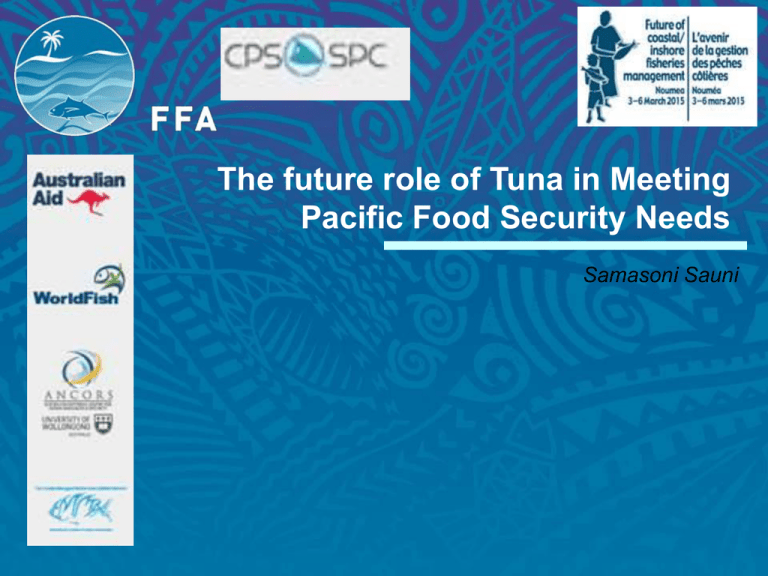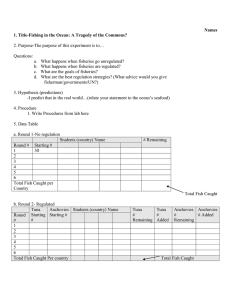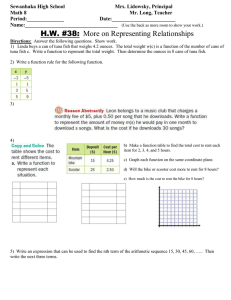The future role of Tuna in Meeting Pacific Food Security Needs
advertisement

The future role of Tuna in Meeting Pacific Food Security Needs Samasoni Sauni Talk Outline Overview Why tuna matters to food security (food, health and money) Strategic interventions Conclusion Overview • Pacific States EEZ ca. 30,569,000 km2 of WCPO; Pacific States landmass ca. 552, 789 km2 • Disproportion of ca. 2% of land to EEZs suggests food security should never be an issue for Pacific States • fish consumption in local communities • Pacific States “fisheries waters” offers probably higher than other in the world many opportunities incl. fish resources • close to 20,000 regional jobs in 2013that – support food security in local covering crewing, processing, govt. communities personnel and observers • ca. USD323 million in access fees • expenditure by locally based vessels Overview - strengths Source: FFA Economic Indicators Report, 2014 Overview - Opportunities Source: FFA Economic Indicators Report, 2014 Why does it matter? (i) Dependence on fish as food The region is 98.5% water; High per capita fish consumption; Very high participation in subsistence fishing; Reliance mainly on coastal fisheries; Coastal resources threatened – deficits emerging. (ii) Benefits of Fish in the Diet 9 out of 10 countries with the highest rates of overweight and obesity, and seven of the 10 countries with the highest rates of diabetes, are Pacific Island nations. Seafood is rich in protein, essential fatty acids, vitamins and minerals Important in combating the high and rising prevalence of non-communicable diseases (NCDs), such as heart disease and diabetes, and the incidence of obesity Concerns of Fish in the Diet Health and wealth benefits or concerns –competition? trade-off? Possible tension (exporting vs. direct food security) Stocks sustainability How Much Tuna is Needed Tuna will need to provide 12% (32,000mt) of the fish required by PICTs by 2020. This will increase to 25% (87,500mt) by 2035 The greatest quantities will be required in Papua New Guinea, Solomon Islands and Kiribati. Source: Bell et al. 2015. Diversifying the use of tuna to improve food security and public health in PICTs. Marine Policy, 51 (584-591) Increasing access to fish Low-cost inshore Fish Aggregating Devices Increasing access to fish Managing the supply of tuna and by-catch from industrial fleets to urban areas For countries with canneries appropriate duty on canned tuna ENSURING FOOD SECURITY & REVENUES FROM THE TUNA INDUSTRY also means managing complex systems, processes and challenges at different points of the supply-value chain Conclusion - the big picture! High dependence of PI States particularly vulnerable island economies on fisheries resources for revenue and food security cannot be understated Any serious threat to the sustainability of fish resource can be viewed as a threat to their economic viability and food security Requires effective balancing efforts on sustainable development, management and conservation of fisheries and fish resources and their ecosystems 20% of people in most PI States live in hardship, meaning they are unable to meet their basic food and non-food needs. Tuna fisheries contribute significantly to revenue streams into vulnerable island economies, incl. those employed in this sector throughout the value chain Support small scale fisheries operations, and domestic basing of commercial fisheries if circumstances allow Accessible to food fishes including tuna and semi-pelagic species provides comfort to local populations Threat of NCDs in PI States is as acute as it is anywhere else. Need to steer away from unhealthy diets that include cheap imported meat offcuts e.g. turkey tails, lamp flaps, etc. Encourage consumption of tuna and other fish related products and not imported cheap meat Much need revenue from tuna fisheries help Pacific Island governments manage growing epidemic of NCDS amongst local communities More broadly food security in the context of tuna in Pacific States also means: Sustainable fish stocks Maximum economic benefits and social livelihoods Strict controls and high level of compliance Well resourced and enforceable MCS tools to eliminate IUU activities Tangio tu mas!




